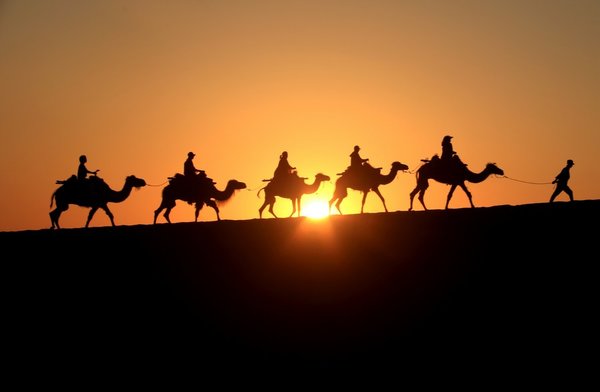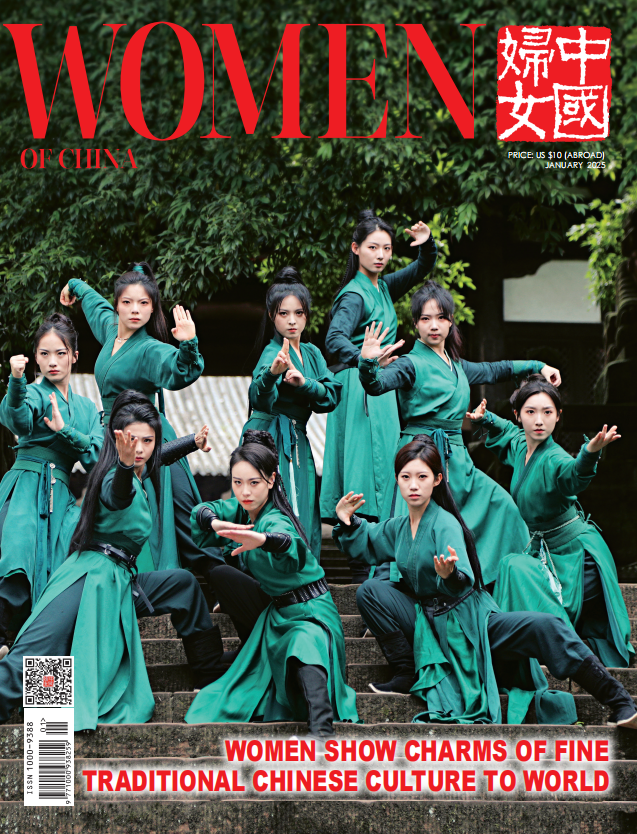Cultural Exchange Keeps Ancient City Alive
 |
| Visitors ride camels at the mingsha mountain and crescent spring scenic spot in dunhuang, northwest China's Gansu Province, June 7, 2023. As a key pass along the ancient Silk Road, Dunhuang is home to the Mogao Grottoes, a UNESCO World Heritage Site that boasts a vast collection of Buddhist artworks — more than 2,000 colored sculptures and 45,000 square meters of murals are located in 735 caves. [Photo by Zhang Xiaoliang/Xinhua] |
LANZHOU, June 26 (Xinhua) — A new sand-yellow cave theater erected on the fringe of the Gobi Desert in Dunhuang City, northwest China's Gansu Province, is bringing the millennium-old grottoes to life.
The new performance staged at the theater, Ancient Sounds of Dunhuang, draws inspiration from the Mogao Grottoes, a UNESCO World Heritage Site boasting rich collections of Buddhist artworks. The dance, musical instruments, and even melodies the show presents all come from the murals.
"The audience can hear the timbre of the Indian five-stringed pipa and the Persian konghou and enjoy the elegant dance performance, a perfect showcase of how Chinese and Western art blended in Dunhuang in ancient times," said Zhang Hua, the director.
Cultural diversity is Dunhuang's name card. Since ancient times, Dunhuang has been a place where many ethnic groups live together.
In 111 BC, Emperor Wu of the Han Dynasty (202 BC-AD 220) formally established Dunhuang City to manage the Western Regions. In the Sui and Tang Dynasties (581-907), Dunhuang was a major stop on the ancient Silk Road and was one of the first trading cities encountered by merchants arriving in China from the West.
With the prosperity of the ancient Silk Road, this border city, lying in an oasis at the edge of the desert, has gradually become a place where multiple civilizations blend and merge, giving birth to Silk Road treasures represented by the Mogao Grottoes.
The collections of the Dunhuang Academy, with treasures such as clay Buddha statues of the Tang Dynasty, silver coins of the Sasanian Empire, and various documents written in ancient Tibetan, Mongolian, Syriac, Brahmi and other languages, also tell vivid stories of the booming cultural exchange in its history.
"The Chinese nation has been drawing on other cultures with a broad mind, and this inclusiveness is very obvious in the Mogao Grottoes," said Zhao Shengliang, Party chief of the academy.
"Because of constant exchanges with foreign cultures and absorbing and making good use of their essence, the Chinese civilization with Dunhuang culture as part of its quintessence has lived on for thousands of years," Zhao added.
Since the 1980s, authorities in Dunhuang have actively carried out international cooperation in the protection of cultural relics.
To digitally protect cultural relics, Dunhuang Academy has borrowed the technology used by the United States to measure and design tunnels, bridges, and other buildings and explored and established a set of advanced digitalization procedures in the digital collection, processing, storage, and display of cultural relics, and became a leader in the field of cultural relics protection in China.
By the end of 2022, the Dunhuang Academy had finished compiling digital data collection on 278 caves, image processing for 164, and the 3D reconstruction of 145 painted sculptures and seven ruins while delivering a panoramic tour program for 162 caves.
Since 1979, Dunhuang has welcomed tourists from more than 100 countries and regions. To Du Yongwei, an inheritor of Dunhuang color sculpture making who is in his 60s, the influx of foreign tourists after China implemented the reform and opening-up policy still leaves a vivid mark in his memory.
"In the 1980s, almost everyone in Dunhuang knows some foreign language, and providing multilingual menus in restaurants and hotels has been a convention," Du recalled.
After China launched the Belt and Road Initiative in 2013, Dunhuang, through a series of high-profile events and platforms, including the Silk Road International Cultural Expo and Digital Dunhuang, has again taken the world by storm with its splendid culture and open-mindedness.
Chen Lisong, a Shanghai designer who has traveled to Paris, Florence, and other famous "art capitals" of the world, takes Dunhuang as the starting point of her business.
"Dunhuang's inclusiveness truly externalizes the characteristics of traditional Chinese culture in my heart," she said.
(Source: Xinhua)
Please understand that womenofchina.cn,a non-profit, information-communication website, cannot reach every writer before using articles and images. For copyright issues, please contact us by emailing: website@womenofchina.cn. The articles published and opinions expressed on this website represent the opinions of writers and are not necessarily shared by womenofchina.cn.






.jpg)

 WeChat
WeChat Weibo
Weibo 京公网安备 11010102004314号
京公网安备 11010102004314号